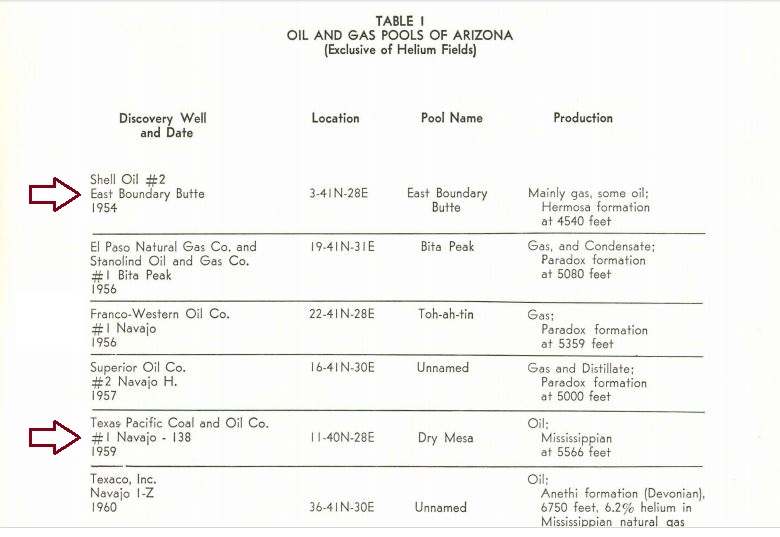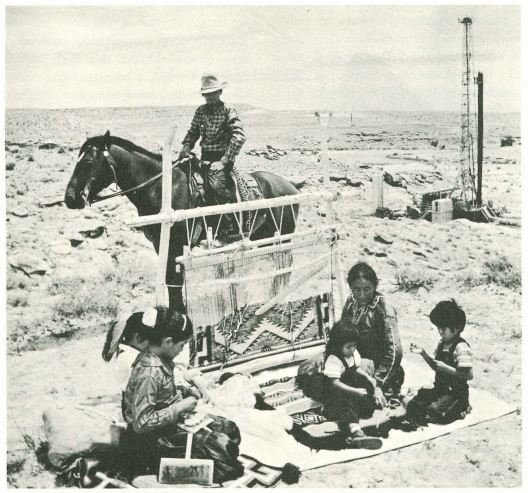Navajo Nation wells produced oil, natural gas, and helium in the 1950s.
Reports of natural seeps in the late 1890s encouraged exploration for commercial quantities of oil more than a decade before Arizona statehood in 1912. Finding a productive oilfield would prove elusive.
At the start of the 20th century, Joseph Heslet, a part-time prospector from Pennsylvania, drilled several unsuccessful wells that showed traces of oil. His efforts caught the attention of other exploration companies, including several that arrived from the 1901 giant oilfield discovery at Spindletop Hill in Texas.

The cover of a 1961 Arizona Oil and Gas Conservation Commission report featured a painting by E.M. “Buck” Schiwetz. Image courtesy Humble Oil and Refining Company.
A 1905 wildcat well drilled in the Chino Valley, 20 miles north of Prescott, reached a depth of 2,000 feet before being abandoned as an expensive failure. Another well drilled one year later in Graham County was abandoned at a depth of 1,400 feet.
More exploration attempts followed, most lacking knowledge of the emerging science of petroleum geology. The result would be five decades of drilling unsuccessful wells — Arizona dry holes.
“A series of speculative ventures and explorations in oil drilling occurred over the ensuing decades, followed by the discovery of helium, an industrial gas that has become a major industry in the state,” noted a 2004 article at Tucson.com.
Better known for abundant copper deposits, it was the search for petroleum that led to helium discoveries in Arizona.
Although normally low, the concentration of helium in natural gas has been measured from 0.01 percent to 7 percent. Helium content would be enough to confuse residents of Dexter, Kansas, in 1903 when a natural gas discovery well would not burn (learn more in Kansas “Wind Gas ” Well).
In Arizona, Kipling Petroleum Company discovered helium 20 miles east of Holbrook in Navajo County in 1950, but “commercial production of helium in Arizona began in 1961 with the state’s first helium extraction plant producing 9 billion cubic feet of gas over 15 years,” the article explained.
Gas in 1954, Oil in 1959
Arizona became the 30th petroleum-producing state on October 13, 1954, with a natural gas well.
Shell Oil Company completed the state’s first commercial well south of the Utah border on Apache County’s Navajo Indian Reservation. Natural gas flowed after drilling to a depth of 4,540 feet.

Arizona’s first natural gas well in 1954 (top) and first significant oil well in 1959. Image from “Oil, Gas and Helium in Arizona, Its Occurrence and Potential.”
“The first producing well in Arizona was drilled by Shell Oil Company in 1954 on a surface structure known as the East Boundary Butte anticline,” proclaimed a special report by the Arizona Oil and Gas Conservation Commission. The well found natural gas and a small amount of oil.
Shell Oil’s East Boundary Butte No. 2 well indicated gas production of 3,150 thousand cubic feet per day; daily oil production was 3.6 barrels of oil (plus 8.4 barrels of salt water per day) from part of the Pennsylvanian geologic formation, the Hermosa, according to the commission’s report.
The 1961 report, Oil, Gas and Helium in Arizona, Its Occurrence and Potential was published by the Arizona Development Board to encourage further exploration. The cover featured a painting by artist Edward “Buck” Schiwetz (1898-1984), courtesy Humble Oil and Refining Company.

Well site on the Navajo Reservation in Apache County, Arizona. The 16-million-acre reservation extends into New Mexico and Utah. Circa 1965 photo courtesy Shell Oil Co.
One candidate for the first Arizona oil well, according to the report, was Humble Oil Company’s No. 1 E Navajo well, drilled in 1958 near the Shell Oil natural gas well. Although initial oil production was from the same formation (Hermosa), “subsequent production showed increasing gas,” and by 1961 it was considered a natural gas well.
“Additional drilling on this structure resulted in completion of three more wells producing mostly gas with some distillate and oil,” noted Lee Feemster of the Texas Pacific Coal and Oil Company.
“Oil and gas shows were encountered in the Hermosa, Mississippian, and Devonian but to date the production is confined to the Hermosa,” Feemster added.
Learn about the earliest oilfield discoveries in other petroleum-producing states in First Oil Discoveries.
Seismic Anomaly
In 1956, the Franco Western Oil Company drilled a well based on a seismic anomaly in the Mississippian formation and found more natural gas. A well completed a year later by Superior Oil Company also produced significant amounts of gas from the Hermosa geologic zone.
“Encouraging shows of oil and gas were recorded in the Mississippian and Devonian in this test, Feemster noted in the commission report. It was his company, Texas Pacific Coal and Oil, that drilled a test well that finally found commercial quantities of oil in Arizona in 1959.
Founded in 1888, Texas Pacific Coal and Oil Company had established the mining town of Thurber, Texas, and by the early 1900s provided almost half of the coal supply for Texas. In 1917, the company drilled the state’s famous McCleskey No. 1 “Roaring Ranger” well in Eastland County.
“The People’s Field”
Texas Pacific Coal and Oil’s 1959 first Arizona oil discovery, the Navajo No. 1 well, was completed in the extreme northeastern part of the state.

Arizona’s oil and natural gas fields are in its northeast corner: (I) East Boundary Butte; (2) Bita Peak; (3) Toh-ah-tin; (4) Unnamed Paradox gas and distillate; (5) Dry Mesa; (6) Unnamed Devonian oil; (7) Pinta dome helium area.
The Navajo No. 1 well produced 240 barrels of oil per day at a depth of 5,566 feet in the Mississippian geologic formation, according to Feemster, who added, “The nearest Mississippian production at that time was in the Big Flat field more than 100 miles north in Utah.”
In 1967, the Kerr-McGee Company’s Navajo No. 1 well revealed an oil-producing geologic anticline about 4,000 feet deep. That well joined the others producing on the Navajo Reservation in Apache County (reservation land includes 16 million acres in Arizona, New Mexico, and Utah).
By 2012, the Navajo Reservation’s Dineh-bi-Keyah — “The People’s Field” — would produce more than 18 million barrels of oil. Recognizing the importance of advancements in horizontal drilling technology, in 2013 the Arizona Geological Survey issued a report, Potential Targets for Shale-Oil and Shale-Gas Exploration in Arizona.
By 2016, Arizona had 32 operating oil and natural gas wells, according to the state commission. Of the 1,129 wells drilled in the state since 1954, almost 90 percent were dry holes (2014 data). Apache County in the northeast corner of the state has remained the only petroleum-producing county.
By 2023, the state had “no significant proved crude oil reserves, and the state’s few oil wells produced only about 6,000 barrels of crude oil in 2023,” according to the Energy Information Administration (EIA). Arizona produces more copper than any other state.
_______________________
Recommended Reading: Arizona Rocks & Minerals: A Field Guide to the Grand Canyon State (2010); Helium: Its Creation, Discovery, History, Production, Properties and Uses (2022). Your Amazon purchase benefits the American Oil & Gas Historical Society. As an Amazon Associate, AOGHS earns a commission from qualifying purchases.
_______________________
The American Oil & Gas Historical Society (AOGHS) preserves U.S. petroleum history. Please become an AOGHS annual supporter and help maintain this energy education website and expand historical research. For more information, contact bawells@aoghs.org. Copyright © 2024 Bruce A. Wells. All rights reserved.
Citation Information: Article Title – “First Arizona Oil Well.” Authors: B.A. Wells and K.L. Wells. Website Name: American Oil & Gas Historical Society. URL: https://aoghs.org/petroleum-pioneers/first-arizona-oil-well. Last Updated: October 3, 2024. Original Published Date: October 9, 2018.



